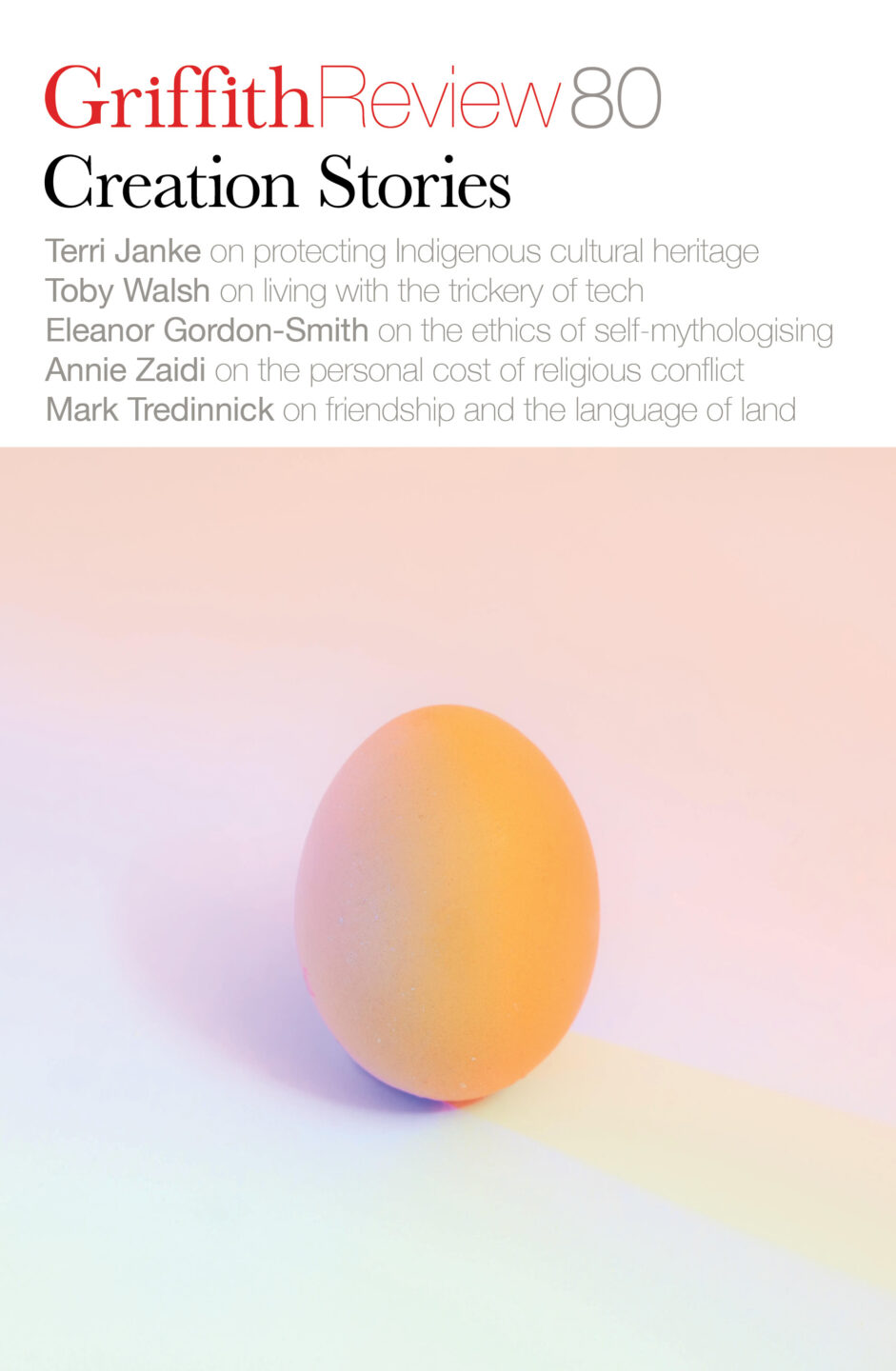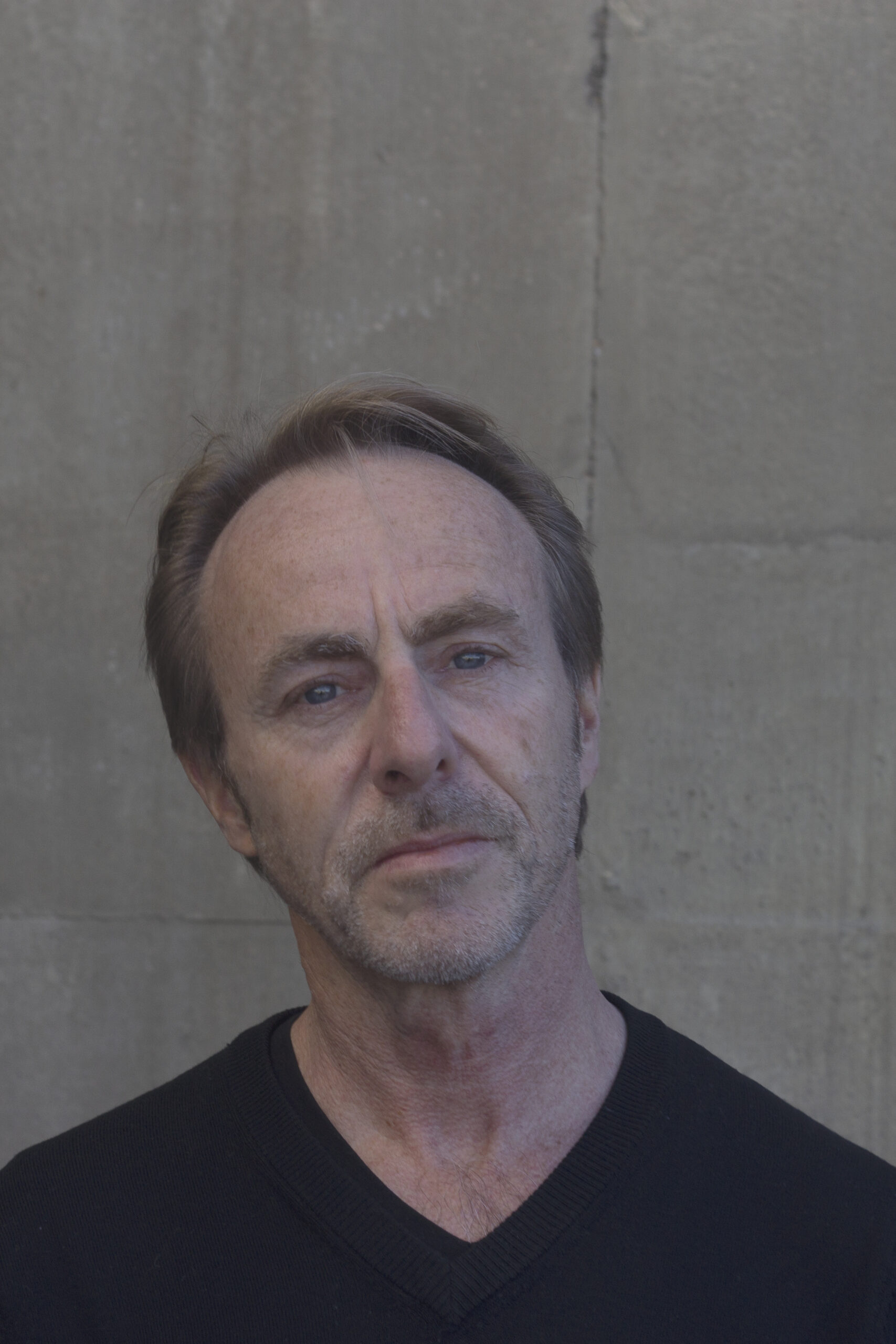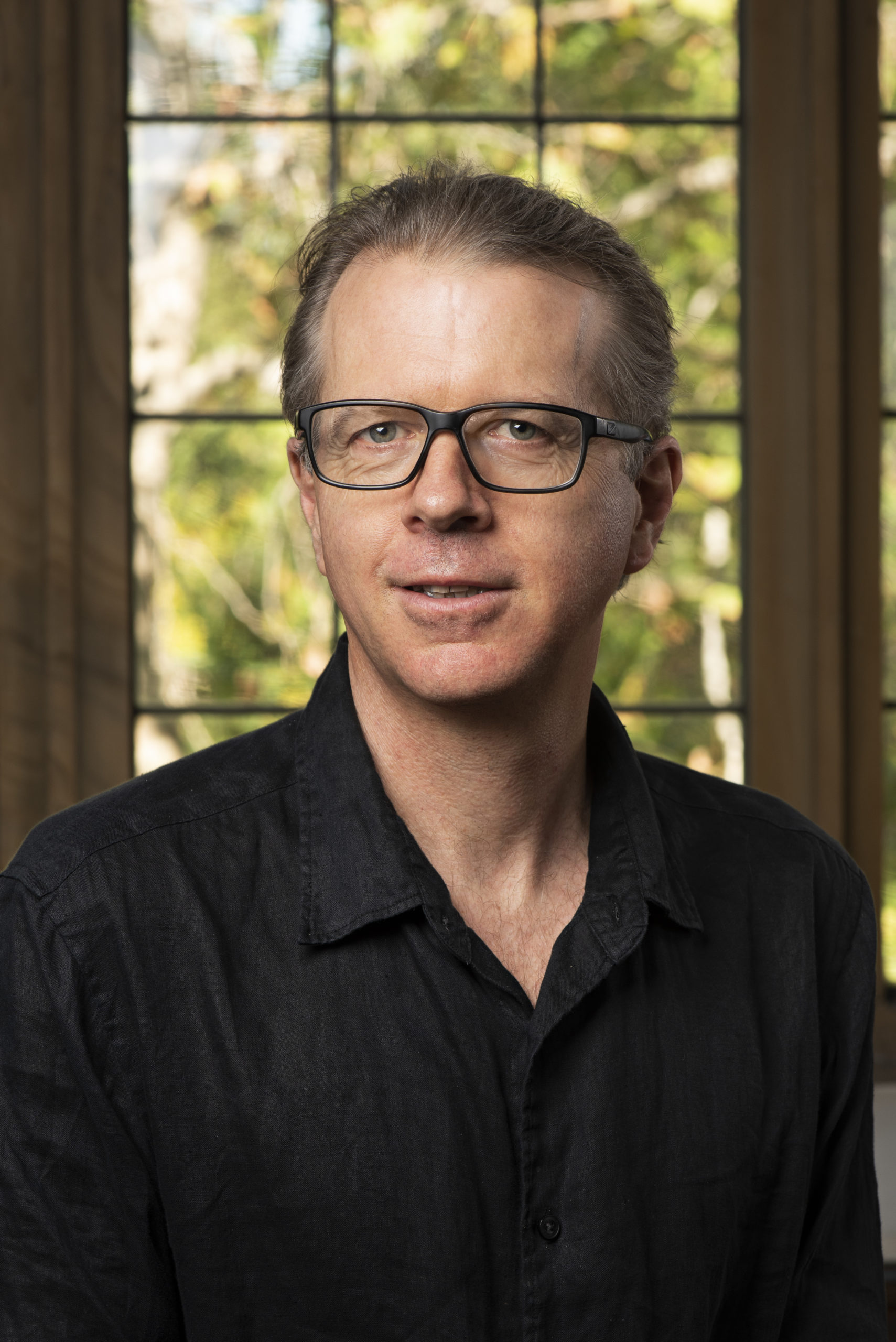Edition 80
Creation Stories

- Published 2nd May, 2023
- ISBN: 978-1-922212-83-2
- Extent: 264pp
- Paperback (234 x 153mm), eBook
The capacity to tell stories – along with language and the ability to create art – is seen as both intrinsic and unique to the human species. Over thousands of years, we’ve forged narratives of our origins, our journeys and our dreams as a means of accounting for who we are and to define our place in the world.
In the twenty-first century, as our existential and environmental crises mount, humanity’s place feels distinctly tenuous. What lessons from the past can inform, even shape, our increasingly uncertain future? And are the stories we’re telling ourselves about what comes next – environmental downfall or technological salvation – helping or hindering what we might do and where we might go?
In celebration of Griffith Review’s eightieth edition and twentieth anniversary, Creation Stories looks to the stars above and the earth below to map our ever-evolving relationships with the world around us. From archaeology and astronomy to AI and transhumanism, the preservation of traditional knowledge to the intricacies of postmodern identity, this edition travels through time and space to explore the many tales of who we are and where we might be headed.
In this Edition
Once upon a self
For Plato, most notably, drama and poetry were to be regarded with intense moral and political suspicion: they made malevolent characters intelligible to their audiences; they use up our real moral sentiments by arousing them for fictional characters; and by depicting certain traits and tropes they risked seducing audiences into acting them out themselves.
On undoing
I am forty before I visit Europe, still ignorant that a century before me my great-grandfather had walked those same cobblestones. That he had fought in a war that did not reward him with any meaningful welcome on his return home. Now that I know, I yearn to go back and breathe that air, knowing that William was there.
Into the swamp
Some versions of environmentalism understandably encourage an almost Swiftian misanthropy, with the ecological collapse framed as the inevitable response of nature to a pestiferous humanity, the only species that, by its very existence, destroys all that it touches. But maybe, just maybe, it doesn’t have to be that way.
A Martuwarra Serpent stirs in its sleep…
Aboriginal people are usually confident in the enduring nature of knowledge (not just belief) because that other mob down the road has the same story, or a similar one. It is a multispecies and layered story, and that is precisely what makes it creative, unlike so much of continuing Western materialist ideas and practices.
Everybody loves beginnings
Beginnings are a breaking of silence that give some indication as to why the silence ought to have been broken, and the prospects of such a breaking. Why should I have broken my silence and begun this discourse? And why should the difficulties of breaking this silence, difficulties that for some reason I must enact in order to ameliorate, appear so manifestly predictable to me?
The emperor’s new opponent
Ask many of my colleagues to define AI and they will tell you…that it’s about getting computers to do tasks that humans require intelligence to perform. Or, to put it another way, it’s about faking human performance on intelligent tasks.
On the right track
When the National Cultural Policy was released, the Albanese government stated their commitment to developing legislation to protect Indigenous Cultural and Intellectual Property. At last there will be a legal framework which can not only protect Indigenous peoples’ rights, but also set the pathway for better sharing of culture and greater respect for Indigenous cultures as the oldest living cultures in the world.
Filling the void
These failures of clean-up, or ‘mining legacies’, are the result of booms and busts – of minerals drifting in and out of favour. Nothing is as precious as a hole in the ground – until that hole in the ground is worth less than nothing. When a boom ends and a resource’s price plummets, a quarry’s metamorphosis from asset to liability can take place in an instant. When abandoned mines are located in out-of-the-way places, populated by those with little political influence, tailings may simply be left to blow in the wind.
Adhi danalpothayapa
For all the clans on Saibai, both migrations were distressing, uprooting families from their homelands where they had lived for thousands of years. Nevertheless, knowledge produced from these migrations has been embedded in stories chronicling the changing climate, and shared throughout the generations. A strong sense of pride is conveyed when recounting these narratives of adaption and resilience. Story is the key because the wisdom is in the story.
Sad stories you are old enough to hear
Those were innocent years, those years before a teenager called Junaid was murdered in a train while looking visibly Muslim. Before we began to hear whispers about whether it was a good idea to travel by train since reservation charts were pasted on the platform and outside each compartment, a list of passenger names alongside seat numbers; how that made it easy to target someone based on their identity.
See through a glass darkly
On the way home that night we pass Oxford Street. It’s lit up and people are dancing in the windows of the clubs. There’s a rainbow flag on one of the buildings. Dad turns to look at this with a grimace: he shakes his head and sucks his teeth. He turns the volume up on the CD player and focuses on the road ahead.
On the forging of identity
The night Sartre spoke in Paris can be seen as a hinge in time, the moment when modernity and its focus on individual identity came to the fore after the destruction of the old order. We are still living on the far side of the door Sartre pointed us through. Of course, modernity had a thousand authors. It was the product of billions of lives lived in close proximity. But Sartre, to me, best articulated a modern creed of what it means to be human.
The dancing ground
After some initial research, and only finding one historical reference to a ceremonial ground within the CBD, I confined the puzzle of Russell’s lacuna to the back of my mind. The single reference I found was in Bill Gammage’s book The Biggest Estate on Earth, where he writes: ‘A dance ground lay in or near dense forest east of Swanston Street and south of Bourke Street.’ Not a great lead because it was two blocks away from where it was depicted on Robert Russell’s survey.
To sing, to say
How poetry works – its oracular way, its indirection – is how land works, he saw. Land as a teacher, as an embodiment not only of its own intergrity but of human aspirations and virtues like hope and beauty; land as an educator of the senses; land as a measure against which to prove and compare one’s own and others’ lives, as a theatre for the divine comedy of all human life; land as an elder, as a god, as a library…
The transhuman era
The story of the transhuman era has much in common with the creation myths of old – and with religious tales of transcendence. It heralds the emergence of a powerful – omniscient, omnipresent – force (AI) possessing intelligence that far exceeds our own. And lends itself to stories that play off destruction against what you could term ‘salvation’, in the form of digital immortality.
Pop mythology
Even though I grew up on a small, remote island, I was still heavily influenced by television – particularly the sort of cartoons that would play on Saturday mornings, mornings before school, after school and so on. When it comes to DC and Marvel and all of those superheroes, for me that was ignited by my late grandfather Ali Drummond, my mother’s father, who had boxes of Phantom comics. Phantom was my early introduction to the strong, powerful male being who had supernatural strength and abilities.
The age of discovery
Prior to Homo sapiens, populations might have just moved on or gone extinct in the face of environmental risks, whereas with Homo sapiens we were able to disperse widely across the world despite great ecological challenges. The underlying reason for that may be rooted in our social relations, our high level of co-operation – we don’t necessarily see that with earlier human species.
Colour theory
I’d graduated to skimming transcripts on the Supreme Court website when Susy found the eyeball. There was a feral screech and a minute later she was standing in the doorway to my bedroom. What is that thing in the fridge? When I played dumb, she said in the blue Tupperware. What the actual fuck?
Back to the red earth
Before she opens her eyes, she knows with the very same certainty that she is of this land that Juanjo, her lover and the father of her five guris, isn’t going to be asleep by her side. But she could for once be wrong. So, she stretches out her arm and feels around. Instead, her fingertips touch his perfectly tucked-in bedsheet. His side of the bed is vacant like the rows of this year’s failed crop.
Have you ever seen the rain?
One by one the streets quietened down. A great hush washed over this city. Even the lights at night seemed dimmer. All of life lay dormant. Or maybe not – Toru couldn’t trust his eyes, could he? He had been living on the streets in the clothes he died in, scrounging food from tables outside restaurants and cafés around the city, but those tables were long gone.
Autumn
Tsunami-hit, shoved over at a tilt,
they’ve left the bashed old kovil’s god-thronged tower
standing, tallish, beyond the new one built
to face, this time, becalm, the ocean’s power…
New Scientist
A body we can read and understand.
If only I could put you under
a microscope and transform you
into a symbol to unite our disciplines:
the communication phage.
Antecedent
Between one end of the gap and the other
the gravity of our gaze can but scratch like banksias
at your fingertips before starlight splits the present
across his teeth into pearl and lime stanzas.
Medea – towards the end
She wanted to confuse the staff
and brings in a pebble from the
garden as suggested, placing it
into the pocket of the man in
the next room.
Rare
There are many ways to carry a story. My father smothered his stories with bravado. Here he is, laughing at the sea drenching him on the deck.
A Little Box
And didn’t I grant you
six identical faces, each perfectly
plain as the other
and a sturdy mouth to clasp shut?



